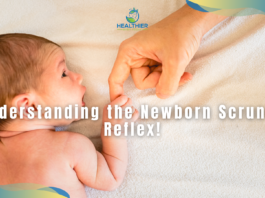The top 8 benefits of a teething ring with Healthier Baby Today! Teething is one of the most challenging stages of a baby’s life. It begins six months into the pregnancy. It is caused by the tooth protruding through the gums. Teething is the process of developing new teeth. Teethers are an ordinary yet often necessary tool many parents use to keep their child’s gums from becoming painful while teething! Baby teething rings are intended for babies to grasp and chew on to alleviate the pain and discomfort they feel as their first set of teeth emerges. Teething rings for babies can also be used as sensory toys. Plastic and silicone teething rings are the most prevalent types of teething rings for babies on the market. Some may contain loose plastic shards and the well-known dangerous toxin BPA (Bisphenol – A).
Bisphenol A (Bisphenol A). BPA contains endocrine disruptors, which can disturb the body’s hormonal balance. When teething rings are utilized, they tend to be in and out of babies’ mouths during the day and night, which can pose a health danger if the plastic type of teething rings is used continually. What are your options? Wooden Teething Rings come into play. Wooden teething rings are unquestionably safer because they are made from natural materials and do not include synthetic chemicals or non-toxic materials. Numerous wooden teething rings are available, including cherry wood, walnut, madrone, alder, and myrtle. Hard maple wood is the most commonly suggested.
What are the Benefits of Wooden Teething Rings?

Teething can begin between 4 and 10 months, and you’ll surely know when it does! Our dear tiny ones are subjected to great agony and irritation during this challenging time of their young lives. Excessive sobbing, swollen and red gums, irritability, loss of appetite, flushed cheeks… Fortunately, we have teething rings that can relieve babies’ pain and suffering during teething. There are numerous infant teethers on the market, but many include plastics, BPA, and other potentially hazardous substances that we do not want in our children’s mouths! If your kid is currently teething, we wanted to shed some light on one type of teething ring that is perfect – wooden teething rings!
- Non-toxic and free of chemicals – One of the critical advantages of choosing wooden teething rings over plastic or other popular baby teethers is that they are non-toxic and contain no dangerous lead, metals, BPA, chemicals, or phthalates. The excellent wooden teething toys’ safety factor is why we decided to stock them and recommend them to parents. We want our clients’ children to be as safe as possible. Thus we provide the most fantastic safes and supplies.
- Durable – Wood is significantly more durable than polymers, commonly used in baby teethers. This implies that your wooden teething ring will outlast any plastic or low-cost teether you might buy for your child. Because of their resilience, these wooden teething rings last longer, resulting in less waste from otherwise throwaway products. The endurance of these wooden teethers leads us to our second advantage: sustainability.
- Sustainable – Most of our baby teething rings are beech wood. Beechwood is unique because it may be grown in renewable and managed forests. This means that additional trees can be planted to replace those that have been used and taken down. Sustainability is a massive aspect of all products we carry at Nordlife. So, of course, we chose these fantastic wooden teething rings as the most excellent option for calming babies’ gums!
- Natural antimicrobial properties – Did you know about this one? Wood has natural antimicrobial qualities, making it naturally antibacterial. What a fantastic idea! As parents, we are constantly concerned about germs in our children’s environment; thus, this feature of wooden teething rings is a great advantage! Baby teethers are continuously in newborns’ mouths. Thus this factor is very vital for a product like this one. So you now understand the several advantages of choosing hardwood teething toys over plastic, metal, or other infant teethers.
- Simple to Clean – Wash them in lukewarm water with soap or in the dishwasher’s top rack. Natural wood teethers are simple to maintain and clean. The wooden teether can be readily cleaned with a moist cloth and clean water, but avoid soaking in water to avoid harming the wood.
- Soothing – Before giving your infant the silicone teething teether, place it in the refrigerator or freezer. A cool teether can help to relieve your baby’s sore gums.
What is the Best Wood for Wooden Teething Rings?

It is advisable to select a gutta-percha of natural or organic wood that is free of preservatives. Hard maple teething rings are the most popular, but walnut, myrtle, Madron, and cherry toys are also available. Most hardwood varieties can be used to make a safe toy for your youngster to chew on, but softwood should be avoided. This is because cork (or evergreen trees) may contain natural oils that are harmful to newborns. Some parents are concerned that dirt and pointy tips of wooden teethers would stick to their baby’s gums. Some producers add oil and beeswax to coat the wood, preserve it from harm, and keep it from chipping. Remember, you must exercise caution while selecting wooden teething toys, as not all oils may be safely applied to your baby’s gums.
What to Avoid in Teething Rings
- BPA, or bisphenol-A, is a chemical found in plastics that mimics estrogen and disturbs the body’s hormonal processes. It is hazardous for pregnant women, newborns, and small children. Even though most regulatory organizations, including the FDA, say BPA is safe in the minimal amounts found in plastic items, several companies have chosen to create and promote BPA-free plastics. Excellent! Except for one minor detail: many corporations substitute BPS — bisphenol-S — for BPA, which is just as harmful, if not more toxic, than BPA. What’s the bottom line? A product labeled as BPA-free does not guarantee it is safe.
- PVC, or polyvinyl chloride, is the world’s third most common material – and also the most dangerous. It’s terrible stuff; you don’t want it in anything your children eat.
- Phthalates are mixed into plastics to make them softer and more pliable. (Because PVC is rigid and brittle, making a squeezy toy requires the addition of phthalates.) Phthalates, however, do not attach to plastic and leach off over time. Babies who chew on phthalate-containing teethers are eating a recognized carcinogen. To check labels, Baby Center provides a great list of phthalate names.

If you’re concerned about plastics or your baby’s reaction to rubber, wood, and fabric, teething rings are ideal. There are plenty of excellent options. Because they are natural, chemical, and plastic-free, wood-made teethers are safer.
History of Teething Rings
Teethers were frequently fashioned of wood or bone in the past. They were often crafted or coated in gold, silver, coral, and mother of pearl. Unless you were affluent, that is. The wealthy’s teethers and teething toys would have been significantly more beautiful and conspicuous. Today’s parents have a lot more options. The better ones are primarily constructed of wood, silicone, and rubber. They come in almost every shape you can think of, and some of them even vibrate! There are literally thousands of teethers available, and we’ll offer you a fast rundown of those now accessible.
Are Wooden Teething Rings the Best?
Wooden teething rings are unquestionably a safer option. They are natural items that do not contain synthetic chemicals or non-toxic ingredients. Wood’s antibacterial characteristics make it a natural antibacterial agent, aiding in the soothing and relief of teething pain in babies. Because we are all concerned about infection in toys that youngsters chew, this feature is a significant benefit for wooden teething rings.
All Natural
Teething occurs relatively early in a baby’s life, so they have a strong desire to bite on anything they can. Teethers come in handy here, as they aid in alleviating the pain associated with a newly formed tooth. Wood is the best base material available since it offers various advantages, including durability, antibacterial characteristics, and non-toxic.




